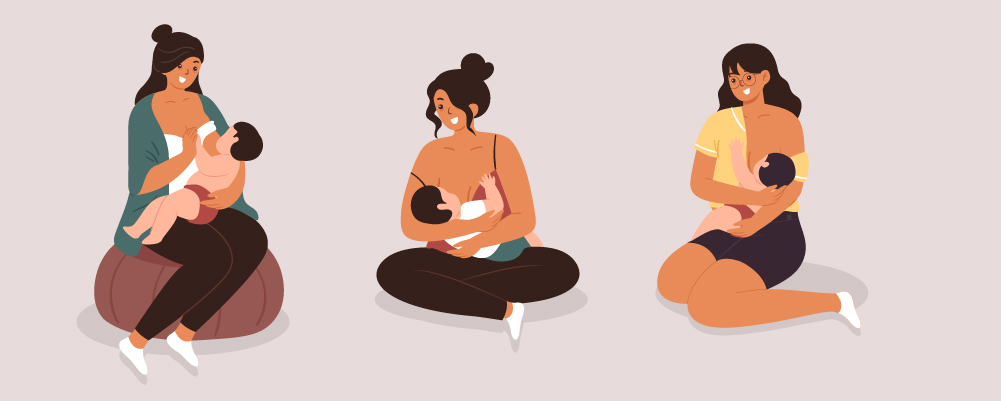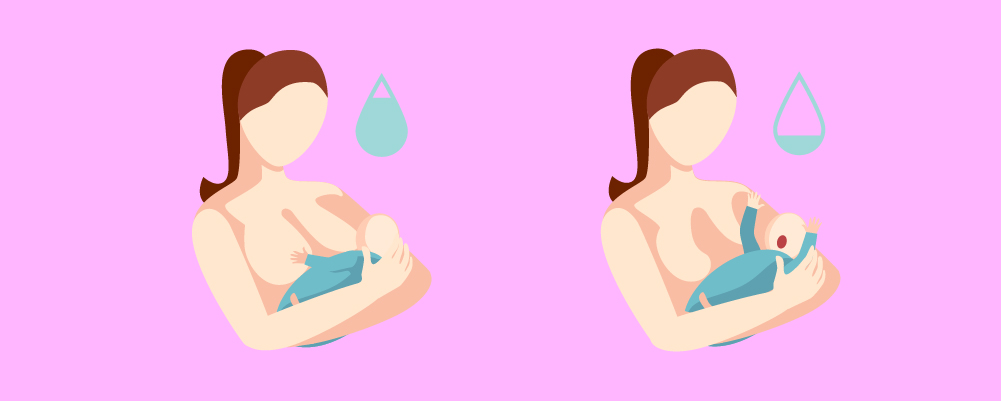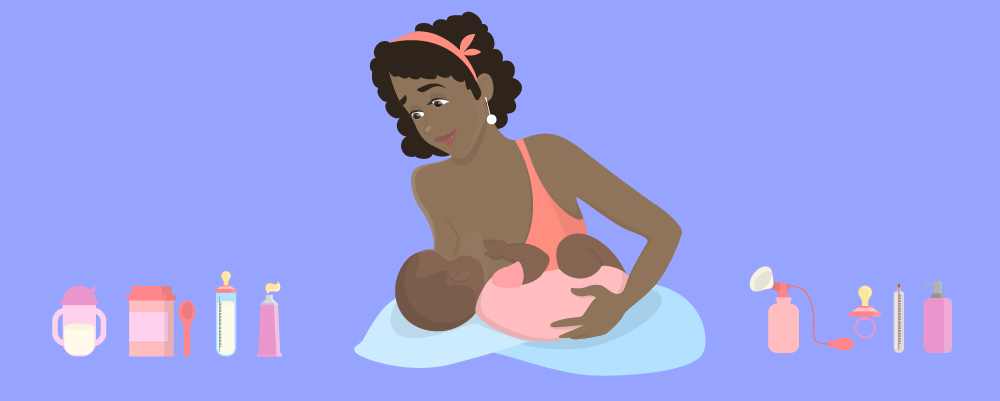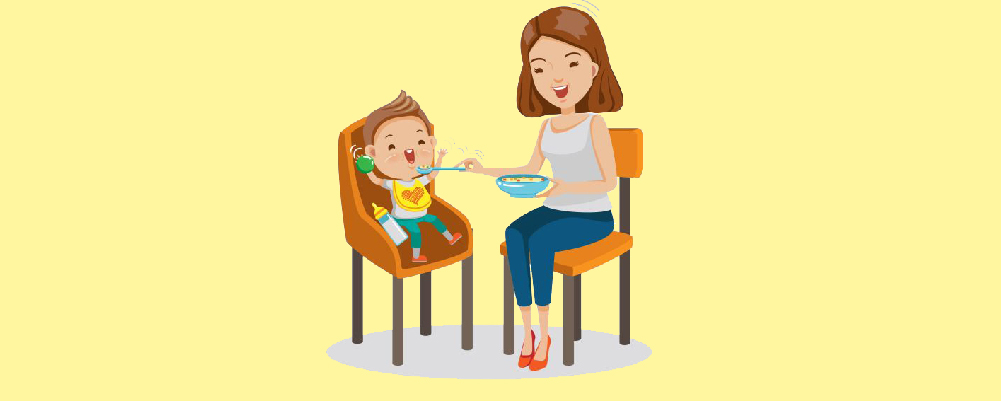Introduction: Where to Start
View in gallery
Becoming a parent for the first time is a pretty overwhelming experience. If you’ve never babysat before or spent long periods of time around infants and newborns, it can be difficult to know how to do some of the basic tasks.
Things like changing a diaper, learning to understand their wants and needs and burping a baby can all seem very alien at first.
Likewise, learning to feed your baby is an experience at first if you’ve never been through it. How can you tell that your baby is hungry for example, how do you keep them on a schedule?
If you’re feeling a little bit out of your depth, then we’re here to help. Read on for our complete guide to feeding your baby.
How to Know if a Baby is Hungry?
View in gallery
Babies can’t communicate with their words, so it’s up to the caregiver to understand their child’s natural hunger cues. Here are some ways that you can tell if your baby is hungry:
- Hungry babies may make faces to indicate they are hungry
- Lots of movement or suddenly waking up
- The baby may move their head from side to side
- They may put their hands into their mouth
- Sucking on lips or tongue
- They may move to face your breast when you are holding them
- Crying
- Making mmm sounds
These are just a few of the common signs that your baby is hungry, but it’s important to remember that each baby is different and so they will have different ways of communicating their needs to you.
You will likely see signs that your little one is hungry around 2 or 3 times an hour. You shouldn’t worry too much if you miss a sign that they are hungry though – they are pretty persistent and will keep giving you signs.
The more that time goes on the more signs your baby will give you. For instance, if your baby is hungrier they may try to move their head from side to side with their mouth open trying to look for food.
Late stage hunger cues include crying, fussing and wriggling.
When they are around 6 to 8 weeks old, it should be noted that you shouldn’t solely rely on your baby trying to eat their hand as a sign that they are hungry.
This is because they will begin to have more control over their bodies and hands so they are more likely to try and explore their new sense of movement using their mouths.
How can you tell when your baby can’t eat anymore? Look for signs such as your baby releasing your breast or the bottle. They may also try to turn away from your nipple, and they will start to relax their body and fists.
You can try burping them and changing their diaper afterwards to see if they are completely full, then offer them another breast.
How Much Should I Feed Babies?
View in gallery
The answer to this largely depends on your baby and their age. For instance, your baby may need more food when they’re having a growth spurt. It also depends on just how often your baby feeds and their habits.
As your baby gets older, they will drink more every time you feed them. Eventually, you won’t need to feed them as many times in a day because their stomachs can retain the food much better.
For every month older that your baby gets, they will likely need about one ounce extra per feeding. This caps at around 6 months of age when your baby will eat around 7 to 8 ounces during each feeding.
When your baby is a newborn up until they hit 2 months of age, about half an ounce of milk or formula each time they feed is pretty normal.
Eventually, this will increase to 1 to 2 ounces. When they’re 2 weeks old they should be drinking roughly 2 to 3 ounces each time they feed.
When the baby hits 2-4 months old they will likely be eating 4 to 5 ounces each time they feed.
Then, when your baby is 4-6 months old they will be eating between 4 and 6 ounces each time they feed, eating 8 ounces at 6 months old.
You can usually tell if your baby is eating enough because you’ll end up with around 6 wet diapers a day and their bowel movements will be regular. They will also gain weight.
What to do if Baby is Hungry After Eating?
If your baby is still hungry even after they’ve eaten, you may be worried about what to do next. Do you need to feed them extra, or is it time to put them on solid foods?
First of all, it should be noted that sometimes a baby’s hunger cues can be misinterpreted as a need for something else. For instance, your baby may want to suck because it makes them feel comforted.
Maybe they just want to have a cuddle with their parent instead. Try changing your baby’s diaper or play with him, and if nothing works then you can consider whether your baby needs to be fed again.
Alternatively, it may be that your baby needs a little bit of extra food. If you’re bottle feeding your baby and they still have some of their bottle left, then feed them what remains and give them an extra half an ounce.
You may find that your baby just needs to be fed more as they are feeding. If they don’t spit up the bottle afterwards, then this can indicate that your baby needs to eat more during each feed.
Also, not all babies feed the exact amount each time. They may not eat as much at one point, then the next time you feed them they want more.
Just make sure that you follow your baby’s feeding cues – don’t force them to eat. If your baby is reaching for more food then honor that.
Guide on Feeding Babies
View in gallery
The amount and type of food that you need to feed your baby will differ based on various aspects, such as their age and habits. Here are a few things that you should keep in mind.
Age
Newborn
Understanding how to feed your newborn can be a little challenging, especially when they’ve just been born and you aren’t yet familiar with their hunger cues and mannerisms.
So, what about the very first day that your baby is born? Your baby’s stomach is incredibly small, so you are going to need to feed them a lot.
In fact, during their first few days of life, your baby will likely want to feed between eight and fifteen times a day. That’s a lot of meals!
It can also be a little difficult to navigate the feeding process. If you’re planning to breastfeed then you will need to get your baby used to latching – your midwife will usually show you how to do this.
Not all mothers and newborns take to it immediately though and it can take a while to get used to it. You’ll get the hang of it eventually though!
You should try to feed your baby whenever they appear to want to eat. It can help to keep your baby close to your skin when feeding them.
Your newborn will likely need between eight to 12 feedings every 24 hours. It can help to look for the hunger cues that we mentioned above to see if your baby wants to eat.
There are some newborns that also lose weight in the first couple of days after they’re born and it’s normal for them to lose up to 10 percent of their birth weight.
They will put that weight back on again when they are around 5 days old.
When your baby is a newborn, you don’t need to feed them anything other than breast milk or formula.
For the most part breast milk is the best choice for your baby, though this isn’t always possible for all parents to provide. This is not the time to be feeling your baby anything else like water, cereal or juice.
One thing that can be helpful for new parents is to view every feeding time as an opportunity to bond with your little one.
Try to snuggle them close and look them in the eye as you feed them. Speak with a gentle voice, and simply just use the time to develop your bonds and trust with the baby.
If you are having other family members to help you to take care of your baby, it’s also important to have some consistency.
For instance, you need to make sure that your family members are following the same methods and feeding routines as you.
If you have any trouble with feeding your baby, breast feeding or with other matters, don’t be afraid to ask a doctor for help either.
Keep an eye out for warning signs that your baby isn’t eating enough, such as if they aren’t gaining any weight.
Infant
After about 2 months, your baby becomes an infant and will continue to be until they hit around 1 year old. As your baby ages into an infant, your feeding strategy is going to change along the line.
Remember, when your baby is 2 months old they should be eating 5 to 6 ounces a day and should be having between 5 and 6 feedings in 24 hours.
Between 3 to 5 months your baby should have 6 to 7 ounces and should be fed from 5 to 6 times a day.
It is during this stage that you need to start looking for signs to start feeding your baby solid foods. The vast majority of care providers suggest starting to introduce your baby to solid foods when they hit around 6 months of age.
This, of course, will depend on your baby’s needs and how ready they are to start feeding on solids.
Before you start feeding your baby solid foods you should first get the go ahead from your doctor. To get them started you should choose a time of the day when your baby isn’t tired or grumpy.
They shouldn’t be excessively hungry but should be a tiny bit hungry. We’ll cover more about getting your baby started on solid foods later on!
When your baby is an infant, there are certain foods you should avoid as they can result in your child developing allergies to certain foods.
For instance, peanut allergies can be quite common so you will need to speak to your doctor about how you should introduce your child to these foods. Be aware of any signs of allergies in advance so you can get medical treatment.
Toddler
By the time your child is a toddler, they should have been eating regular food for quite some time. Be warned though, some toddlers can be picky and may begin to refuse to eat certain foods to get their own way!
You should make sure that you are giving your toddler a balanced diet that will contain all of the vitamins and minerals that they need to live a healthy life.
Fussiness is fairly common as your child begins to develop their own sense of independence.
When your child is being fussy it can be easy to get frustrated and angry. Try to stay calm if possible though. It’s important that eating is a positive experience for your child and conflict can make it unpleasant for the toddler.
Your toddler should have a balance of healthy foods throughout the week but for a while you should allow them to decide the amount that they will eat. They will generally eat what they need.
Aside from meals you should also try to give your toddler some snacks throughout the day. You should make sure that they have a drink when they are eating too.
Unsure about what snacks to feed your toddler? The following are good options:
- Little sandwiches
- Egg and toast soldiers
- Fruit
- Pancake with milk
- Yogurt and berries
- Cheese cubes
- Cherry tomatoes cut in half
You should also try to get your toddler into an eating routine, spacing any snacks evenly in between their meals. It can also help to bring some fun into mealtime by offering small portions of sweet foods.
You should also try to eat with your toddler if possible – never underestimate the power of role modeling! Your child is more likely to eat healthy foods if you do!
If possible, try to limit foods that are high in sugar and fat, chocolates and sweets, and any salty foods.
Breastfeeding vs Bottle
If you’re unfamiliar with feeding a newborn baby, you may be unsure whether it’s best to breastfeed or bottle feed your baby. Here’s everything that you need to know.
Breastfeeding Benefits
Breastfeeding is highly beneficial, not just for your baby but also for mommy! There are a number of benefits to breastfeeding, such as:
- Less likely to irritate your baby’s stomach
While formula can be highly beneficial in many respects, it can sometimes have a habit of irritating your little one’s stomach. Your breast milk, on the other hand, is much easier for their
- Lower risk of SIDS
Sudden Infant Death Syndrome is a tragedy that no parent wants to experience. Some studies have indicated that breastfeeding may reduce the risks of getting SIDS.
Breastfed children make up half as many SIDS deaths as formula fed infants.
- Great nutrition for your baby
Many healthcare practitioners will suggest that you solely breastfeed for the first 6 months of your baby’s life, perhaps even longer.
This is because breast milk will give your baby everything they need for developing during their first 6 months of living.
What’s even cooler is that the composition of the breast milk even changes depending on what your baby needs as they get older.
Of course, it can be a little alarming to see a yellow looking fluid when you first give birth, but don’t worry. This is a fluid known as colostrum which is high in protein, low in sugar and contains plenty of nutritional value for your newborn.
Formula simply cannot replicate it. You will begin to produce larger amounts of milk as your baby gets older and needs more to ea
- May help to stop obesity later in life
Some studies have actually suggested that breastfeeding your baby may help to prevent them from becoming obese later on in life.
This is because you are less likely to overfeed your baby when you are breastfeeding, and some studies have suggested that mothers who nurse their babies are more in tune with their baby’s hunger cues.
- Includes antibodies
Your baby naturally has a weaker immune system when they are first born as they are unlikely to have encountered many viruses.
Thankfully breastfeeding can help to give your baby some vital antibodies to ward off any nasty bacteria and viruses. This is absolutely vital when your baby is in their first few months of life.
We mentioned colostrum earlier – this particular milk will give your baby lots of immunoglobulin A in addition to some other antibodies.
This gives your baby immunity from a lot of viruses, as it will make protective layers in key parts of your baby’s body.
The formula does not provide these same benefits, and some studies have even shown that babies that aren’t breastfed are more likely to get health problems such as infections, pneumonia, and diarrhea.
- Can help mom to lose pregnancy weight
Looking to shed a few pounds after giving birth to your baby? Breastfeeding may help with that. There are some people that can gain weight when they breastfeed, though most people end up losing weight instead.
The main reason for this is because breastfeeding can burn many calories, and in fact after 3 months of breastfeeding you may even burn more fat in comparison to other mothers that aren’t breastfeeding.
There isn’t a massive difference in this regard between breastfeeding and formula feeding mothers, but the difference is still there.
- Can delay menstruation
When you’re looking after a newborn baby the last thing you want to be worrying about is your menstrual period.
In many respects then, you may be happy to know that breastfeeding on a continuous basis can sometimes delay your menstrual period and ovulation.
Of course this may not be beneficial for many mothers that prefer to have a regular menstrual cycle, but it’s worth noting.
- Can give you some form of birth control protection
You’ve just had a baby, and maybe you don’t want to get pregnant again immediately after giving birth. Perhaps you aren’t quite ready to use your regular method of contraception either.
Well, you will be pleased to know that breastfeeding can act as a form of birth control, though albeit not the most reliable one out there.
There are some conditions to this, however. First of all, your menstrual period should not have resumed yet, you will need to breastfeed for a minimum of every four hours throughout the day.
In addition to this, your baby should not have any bottles, formula or pacifiers, and you must have given birth less than six months ago.
- Helps mom and baby to bond
There’s nothing more important when you have a new baby than bonding. Breastfeeding can actually be a great way to birth with your bundle of joy.
It’s something that you and your little one can share. You can spend time holding them close, hearing their little noises and looking into their eyes. It’s a pretty emotional feeling that many new mothers enjoy.
- It’s eco friendly
Feeding your baby and saving the environment? Yes please! Unfortunately, dairy cows can contribute to global warming as they produce a lot of methane.
This is a greenhouse gas that can be quite harmful to the earth. This is not a concern when you are breastfeeding.
- Cost efficient and Time Saving
One of the biggest reasons that many mothers choose to breastfeed is because of the amount of time and money that it saves in the long run.
Other than buying things like breast pumps and getting lactation consulting, breastfeeding is pretty much free.
For starters, you’re not going to need to spend any money on formula. You also won’t need to meticulously calculate the amount that your baby will have to drink on a regular basis.
Not only that, but you also aren’t going to have to prepare bottles, including cleaning and sterilizing.
There’s no need to start warming up bottles in the middle of the night when your baby is hungry, and you don’t need to worry about warming the bottles up when you’re out and about. It’s pretty convenient as a whole.
Convinced that breastfeeding is the right choice for you? Consult with your midwife or a lactation consultant about what you need to do. A little bit of guidance can go a long way, especially if you’re a first time parent.
Bottle Basics
Not all parents are capable of breastfeeding, and some may not wish to do so – that’s okay! Feeding your baby with a bottle and formula is a great alternative to breastfeeding with many of its own benefits.
Like with breastfeeding though, it can take a while to get used to and it requires a lot of practice to get things right.
First of all, you’ll need to make sure that you buy all of the equipment that you need. You should invest in a couple of teats and bottles and some equipment to sterilize the bottles.
Try to make things a little bit easier for yourself by getting bottles that can be cleaned easily.
If you are planning on exclusively bottle feeding your baby then it’s possible to start right after they’re born.
However, if you plan on breastfeeding and bottle feeding then you will need to wait a couple of weeks before you start feeding with a bottle.
Suggested Reading: Glass vs Plastic Baby Bottles
Your breasts may not be able to provide as much supply if you’re also bottle feeding early on.
Your baby probably won’t eat more than a few ounces maximum each time you feed them every few hours, and bottle feeding comes naturally to babies so you don’t need to worry about that.
Perhaps the biggest advantage of bottle feeding your baby is that anyone can do it, from your partner to your parents. For this reason, it’s important to get everyone on board with how to feed the baby.
It can take a little while to introduce your baby to the bottle, so knowing how to do it off the bat is a good idea.
To make the bottle, sterilize the bottle and wash your hands. Then if you are planning on using formula simply follow the instructions on the packaging.
When you’ve got your bottles ready, sit down comfortably with your baby close to you. Make sure that you hold them in an upright position with their head supported – this will allow them to swallow and breathe properly.
Gently brush the teat of the bottle against their lips and allow them to suck the teat when they start to open their mouth. Be patient as it can take a while for your baby to feed.
It can also help parents to fully focus on the baby when they are being fed so you can recognize any feeding cues.
You don’t want to risk overfeeding your baby. For instance, if your baby starts to turn away from the bottle after a couple of minutes
When feeding your baby, make sure that you tilt the bottle slightly upwards so that the liquid will fill up the teat. If you don’t do this then you may find the teat will fill with some air which is a recipe for disaster and gassy babies.
It’s also useful to get some disposable bottle liners or angled bottles if you want to reduce the chances of your baby getting gas.
Above all else, you should stay away from warming bottles in the microwave, as this can unevenly heat the bottles which results in spots that are too hot and may burn your little one’s mouth.
You should just put the bottle under a little bit of hot water for a couple of minutes, or you can also use a bottle warmer or a bowl of hot water.
Shake the bottle before feeding your baby and check the temperature is suitable for your baby. You can test it by putting a few drops of the bottle on your wrist. It should ideally be at a lukewarm temperature.
Baby Food
When your baby gets a little bit older they will need to start eating solids. It’s at this point that you will need to introduce baby food to their diets.
Of course, it’s important to start baby food at the right time. This is usually when your baby is between 4 and 6 months old.
Your baby should be capable of sitting in a high chair by themselves and they should look interested when mealtime comes around. They should also be able to move the food into the back of their throat.
Baby Foods are usually quite soft, often things like pureed fruits like bananas. This helps them to digest easier as they are not used to chewing yet.
The main thing is getting your baby used to basic textures and tastes, and helping them to learn how to swallow solid foods.
You have two main choices when it comes to baby food: homemade or ready made.
Homemade
There are a number of benefits to using homemade baby food to feed your baby.
For starters, making your own baby food at home is fairly cheap – you are going to be spending more money on readymade baby food.
You will also be able to choose what kinds of ingredients and flavors your baby experiences. There won’t be any preservatives or salt unless you choose to include it.
In addition to this you can also avoid any foods that may cause an allergic reaction. It gets your baby used to the family’s eating habits and this is very important for helping them to maintain a healthy weight as they get older.
The biggest downsides of homemade baby food is that it can sometimes take a while to prepare properly and safely, which may not be ideal for all families.
Readymade
If you don’t have the time to dedicate to making your own baby food at home then you may wish to think about buying some from the store that has already been prepared for you. There are a lot of benefits to this.
For starters, baby food that has been bought at the store all follows very strict food health and safety standards that are set out by the U.S Food and Drug Administration.
Not only that but if you’re on the move or your baby is staying with another family member it’s a portable option that’s easy to access.
You don’t need to worry about preparing the food either, making it the ideal choice for families that are constantly on the go.
You aren’t just limited to one food choice either. There are a wide range of choices available when it comes to baby food, including all sorts of fruits and vegetables that may not even be available in the grocery store at the time.
If you are planning on using store bought baby food then you will need to be incredibly careful to read the labels – make sure that the food doesn’t contain any extra salt or sugar. It can also be more expensive to buy readymade baby food.
Pureed foods are the very first way you can introduce your baby to solids, so take the time to consider what you would prefer to do when setting your baby off on their eating journey.
Solid Food
The next step in the baby feeding journey is solid foods. During this exciting time, your little one gets to begin to experience all of your favorite foods and textures. Of course, there are a few things to keep in mind first.
When Can Baby Eat Solids?
According to the American Academy of Pediatrics, the vast majority of children can start eating solids when they are around 6 months old.
By the time you introduce them to solids, it can be beneficial to have also introduced them to pureed baby food.
Your baby should be capable of eating all sorts of foods at around 7 or 8 months old, such as cereals, meat, proteins, fruits, vegetables and so much more.
You shouldn’t just introduce your baby to solids just because they have reached this age, however.
You need to introduce your baby to solid foods when they are ready. As we briefly touched upon earlier, some common signs that your baby is ready for solid foods includes:
- Your baby is starting to get good control over their head
- They can sit on their own without support, or with minimal support
- Your baby starts to open their mouth and leans forward when you offer them food
Food to Avoid
Feeding your baby all sorts of new flavors and learning what they enjoy can be such a happy experience.
With that being said, there are some foods that you should avoid when you are trying to introduce your child to solids. These foods include the following:
Honey is delicious, but it’s a big no no during your baby’s first year on earth. This is because honey can sometimes contain Clostridium Botulinum spores. Don’t panic – this won’t cause any harm to you. Unfortunately, though it can cause botulism in a baby under 1 year old.
This is a very serious illness that is unlikely to be fatal, but it can cause your baby to have a poor appetite, can result in constipation, lethargy and possible pneumonia and dehydration.
If you’re desperate to feed your baby a pinch of honey, wait until they’re a little bit older.
Cow’s milk has plenty of calcium that’s ideal for a larger body, but it’s not recommended for babies under the age of one. It can be quite challenging for them to digest!
This aside, it also doesn’t contain key nutrients like vitamin E and iron that are crucial for your baby’s growth and development early on.
You can give them whole milk by 8 months old usually though. You should also make sure that your baby doesn’t have an allergy to milk when you do introduce it to your baby.
- Anything that may be a choking hazard
When they’re young, your baby may struggle to eat certain foods that don’t dissolve in their mouth or that they can’t chew with just their gums and this can be a choking hazard.
Until they’re older and develop their teeth, stay away from any foods like whole peas, uncooked raising, fruit like apples and grapes, and any chunks of poultry or meat.
Introduce more foods that they can chew after their molars develop. You should stay away from foods that quite commonly cause choking until your baby is around 4 years old – such as raw carrots, whole hot dogs and popcorn.
Make sure you observe your baby eating them closely and try to slice them up if you are able to do so.
- Unpasteurized foods
You couldn’t eat unpasteurized foods when you were pregnant. Likewise, they shouldn’t be given to your child when they are young.
They can include harmful bacterias and these can result in a life threatening illness for your child. Best to avoid things like raw juice, dairy products and cider until your child is a little older.
- Fruit juices
According to The American Academy of Pediatrics, fruit juices should not be given to babies that are under a year old.
This is because fruit juice doesn’t contain many of the nutrients your baby needs such as protein, calcium, vitamin D and fat.
Your baby may be less inclined to drink breast milk and formula, and having too much juice can even result in diarrhea and tooth decay.
After your baby is a year old, you should still try to stay away from providing your baby with juice before bedtime. They should have small amounts even then.
While there are other foods that you should also avoid, these are just a few of the key foods that you should avoid giving your baby during their first, crucial year.
Tips
- Be patient when you’re introducing your baby to solid foods. After all, eating and chewing are things they have never experienced before so it can take some time to get used to it! Try to also give them a few different foods – it can take a couple of tries for your baby to adapt to the new textures, foods and flavors. Don’t feel dejected if they reject the food or if it’s difficult – it will get easier as time goes on.
- Allow your baby to take some time to explore their other senses as they eat. Let them hold and touch the food and let them feed themselves if they want to. If they want to hold the spoon, let them try it!
- Keep any distractions far away from the feeding area. For instance, stay away from the television. You want your child to be fully focused on the food.
- Practice what you preach! Show your baby the way that you eat, and they are likely to try and copy you. It can help to try and eat at the same time as your baby if possible so they can learn from you.
- Have a routine – wash their hands and prepare them for eating. Make sure that you and your baby are calm and try to eat around the same times each day if possible. Get them used to the experience so that they end up looking forward to meal time each day. You can also use it as a time to bond with your baby.
- Check for the warning signs of allergies. Try to feed your baby just one new type of food at a time and then wait a few days before introducing them to the next. You should look out for things like hives, rashes, wheezing and breathing difficulties when feeding your child something that could be a potential allergy. If the reaction seems serious then go to the ER, if you notice any more minor symptoms then speak to your pediatrician.
Next Steps
View in gallery
Burping
Babies can get trapped wind incredibly easily and really, it’s better out than in! Burping your baby is very important as not all babies are able to burp on their own. That’s where you come in to help.
Air doesn’t always get in the stomach in the same way – sometimes it’s a result of bottle feeding, sometimes it can be because your baby has had a long crying session recently.
If your baby needs to be burped there will usually be some signs. For instance, if your baby is a little more uncomfortable when they’re feeding then you may need to burp them.
If this isn’t the case then just wait until after they’ve been fed. Either way, you’ll know the signs when you see them.
There is a range of ways you can burp your baby, including:
On the shoulder – Put your baby on your shoulder, making sure that their chin is rested there. Make sure that you support their head and shoulders then rub and pat the back. Walking around can sometimes be beneficial too.
On the Lap Sitting – Put your baby on your lap, making sure that they are facing away from you. Then put your hand flat on your baby’s chest, supporting their chin and jaw. Lean them a tiny bit forward and then rub or pat their back.
Lying On The Lap – Again, lie your baby on your lap with their face down. Support their chin and pat or rub the back with the hand that you have free.
Also, read about when to stop burping your baby.
Conclusion: Food Glorious Food
View in gallery
Feeding your baby is an exciting time, especially as they become more accustomed to new and exciting foods. Above all else it’s important to be patient, and take some time to enjoy this time.
Your baby won’t be small forever, and eventually, they’ll be eating whole meals without your assistance!
Citations
https://pubmed.ncbi.nlm.nih.gov/19759351/
https://www.cdc.gov/healthyschools/foodallergies/index.htm






